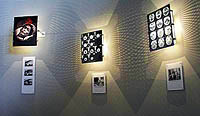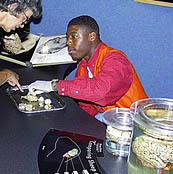|
|
A
Guide Through the Labyrinth of Memory
Memory,
a major exhibition at the Exploratorium, ran from
May 22, 1998 through January 10, 1999. More than 40 new exhibits
grouped into six broad areas guided visitors through the labyrinth
of memory from personal, social, cultural, psychological, and neurological
perspectives. To provide a better understanding of the exhibition,
descriptions of the thematic sections follow.
Memory
was
made possible by the National Science Foundation and sponsored by
Bank of America.
Remembering
Who You Are
Every individual has unique memories--places, people, sounds, and
smells that are personally significant. In this area of the exhibition,
visitors were encouraged to share
 their
earliest memories, or view a display of treasured memorabilia, each
object accompanied by the story of why it's important to its owner.
A multimedia presentation will introduced visitors to the art of
Franco Magnani, a San Francisco resident who painted scene after
scene of his childhood home in Tuscany, all from memory.
their
earliest memories, or view a display of treasured memorabilia, each
object accompanied by the story of why it's important to its owner.
A multimedia presentation will introduced visitors to the art of
Franco Magnani, a San Francisco resident who painted scene after
scene of his childhood home in Tuscany, all from memory.
Sense
Memory
This area explored the evocative power of each of our five senses.
A six-minute video, Precious Images, took you on a whirlwind journey
through the most memorable images from hundreds of your favorite
classic movies. Our "Jukebox Memories" exhibit provided
a blast from the past with the sounds of the top songs of the last
40 years. A tactile guessing game challenged you to identify some
common household objects--things you probably see every day, but
may not recognize by touch. Smell and taste are very powerful memory
stimulants. Visitors got to see what their brains conjured up at
the smell of baby powder, or what they could tell from the taste
of a jellybean.
Brain
 Remembering
is easy for most people. Understanding how and why we remember is
a topic that brain researchers have found to be very complex. This
area of
Memory
examined the physiological basis of memory
in the brain. One exhibit showed how nerve cells communicate with
each other, and daily sheep's brain is dissections, revealed the
intricate structures deep within. Visitors examined tissue from
a human brain with Alzheimer's disease to find out what went wrong.
Remembering
is easy for most people. Understanding how and why we remember is
a topic that brain researchers have found to be very complex. This
area of
Memory
examined the physiological basis of memory
in the brain. One exhibit showed how nerve cells communicate with
each other, and daily sheep's brain is dissections, revealed the
intricate structures deep within. Visitors examined tissue from
a human brain with Alzheimer's disease to find out what went wrong.
Remembering
Without Thinking
Memory is not always a conscious process. In this area, visitors
got to explore the ways that our brain carries memories that we
may not even be aware of. Visitors played "Hoop Nightmares,"
a wacky basketball game which temporarily alters your body's memory
of how to throw a ball, and found out how previous experience can
affect how we see an image.
Remembering
and Forgetting
 You
can learn a lot about how your memory works by seeing its shortcomings,
then learning some tricks to overcome them. This area of the show
was full of exhibits that allowed you test your memory, and discover
some simple techniques to improve it. You handle hundreds of pennies
every week, but can you pick out the real penny from an array of
almost lookalikes? If you saw a face once, could you pick it out
of a lineup? Visitors discovered the differences between long-term
and working memory, and between recall and recognition.
You
can learn a lot about how your memory works by seeing its shortcomings,
then learning some tricks to overcome them. This area of the show
was full of exhibits that allowed you test your memory, and discover
some simple techniques to improve it. You handle hundreds of pennies
every week, but can you pick out the real penny from an array of
almost lookalikes? If you saw a face once, could you pick it out
of a lineup? Visitors discovered the differences between long-term
and working memory, and between recall and recognition.
Shared
Memories
Some events and times are so powerful that they become shared memories--almost
 everyone
over the age of 40 remembers where they were the day that John Kennedy
was shot. This area examined the memories that span a multitude
of consciousnesses. Visitors flashed back to the most memorable
moments of this century, viewed a photo show of powerful and innovative
memorials, or participated in creating a time capsule to pass on
shared memories to future generations.
everyone
over the age of 40 remembers where they were the day that John Kennedy
was shot. This area examined the memories that span a multitude
of consciousnesses. Visitors flashed back to the most memorable
moments of this century, viewed a photo show of powerful and innovative
memorials, or participated in creating a time capsule to pass on
shared memories to future generations.
Memory
is intensely personal, intensely powerful. For each of us as individuals,
our memories establish where we've been, who we are. They are the
threads that connect our childhood selves with the adults we have
become. When we're young and don't have as much to remember, we
take our memories for granted. As our memories grow, and as we age,
they are something we fear losing.
Memory
was a new kind
of exhibition, an experiment that used science and art from a variety
of social and cultural perspectives to help us understand ourselves.
|
 their
earliest memories, or view a display of treasured memorabilia, each
object accompanied by the story of why it's important to its owner.
A multimedia presentation will introduced visitors to the art of
Franco Magnani, a San Francisco resident who painted scene after
scene of his childhood home in Tuscany, all from memory.
their
earliest memories, or view a display of treasured memorabilia, each
object accompanied by the story of why it's important to its owner.
A multimedia presentation will introduced visitors to the art of
Franco Magnani, a San Francisco resident who painted scene after
scene of his childhood home in Tuscany, all from memory.
 Remembering
is easy for most people. Understanding how and why we remember is
a topic that brain researchers have found to be very complex. This
area of
Memory
examined the physiological basis of memory
in the brain. One exhibit showed how nerve cells communicate with
each other, and daily sheep's brain is dissections, revealed the
intricate structures deep within. Visitors examined tissue from
a human brain with Alzheimer's disease to find out what went wrong.
Remembering
is easy for most people. Understanding how and why we remember is
a topic that brain researchers have found to be very complex. This
area of
Memory
examined the physiological basis of memory
in the brain. One exhibit showed how nerve cells communicate with
each other, and daily sheep's brain is dissections, revealed the
intricate structures deep within. Visitors examined tissue from
a human brain with Alzheimer's disease to find out what went wrong.
 You
can learn a lot about how your memory works by seeing its shortcomings,
then learning some tricks to overcome them. This area of the show
was full of exhibits that allowed you test your memory, and discover
some simple techniques to improve it. You handle hundreds of pennies
every week, but can you pick out the real penny from an array of
almost lookalikes? If you saw a face once, could you pick it out
of a lineup? Visitors discovered the differences between long-term
and working memory, and between recall and recognition.
You
can learn a lot about how your memory works by seeing its shortcomings,
then learning some tricks to overcome them. This area of the show
was full of exhibits that allowed you test your memory, and discover
some simple techniques to improve it. You handle hundreds of pennies
every week, but can you pick out the real penny from an array of
almost lookalikes? If you saw a face once, could you pick it out
of a lineup? Visitors discovered the differences between long-term
and working memory, and between recall and recognition.
 everyone
over the age of 40 remembers where they were the day that John Kennedy
was shot. This area examined the memories that span a multitude
of consciousnesses. Visitors flashed back to the most memorable
moments of this century, viewed a photo show of powerful and innovative
memorials, or participated in creating a time capsule to pass on
shared memories to future generations.
everyone
over the age of 40 remembers where they were the day that John Kennedy
was shot. This area examined the memories that span a multitude
of consciousnesses. Visitors flashed back to the most memorable
moments of this century, viewed a photo show of powerful and innovative
memorials, or participated in creating a time capsule to pass on
shared memories to future generations.